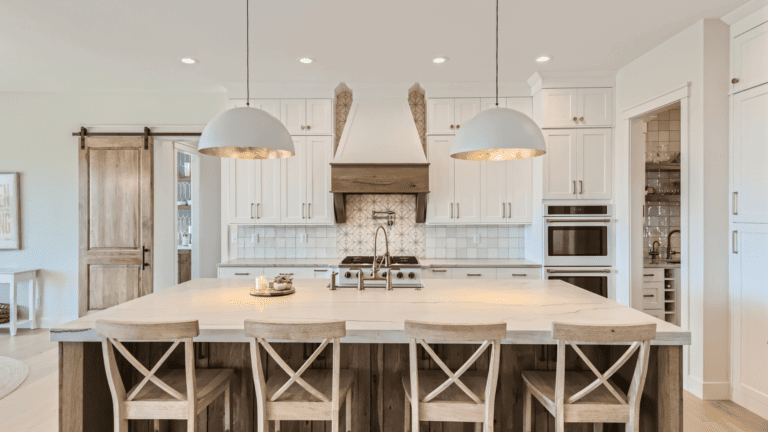A stand-out real estate listing presentation is essential in a competitive market. While a whopping 42% of sellers find their agents through referrals, the other 68% are interviewing agents at listing appointments.
It may feel daunting to create a listing presentation from scratch, but once you finalize a template, you can reuse the presentation repeatedly with slight tweaks to fit each seller.

Your presentation should include all of the high-level things you want to hit while leaving room for follow-up discussions. We recommend keeping your presentation under 15 slides and time it for thirty minutes max.
Here are the slides you should include in every listing presentation:
Presentation Intro/Cover
Every listing presentation needs an intro or cover slide. The intro slide can be straightforward and include a few beautiful real estate photos of your previous listings or even a real estate stock image. For text, include your real estate slogan, your name, and the listing address.
If you have the presentation pulled up for a while as you settle in, this slide may be the one seen the longest. For that reason, make sure it looks super sleek and attractive.
Agenda
After your intro slide, provide sellers with an agenda for the listing appointment. A simple syllabus puts sellers’ nerves at ease and helps them have better insight into what to expect throughout the meeting.
This slide should be high-level without a lot of text. Try formatting it in a way that viewers can read quickly. Below you can see an example of a simple, well-formatted agenda.
Today’s Agenda:
- Learn about your home
- Address your questions and needs
- Provide more information about me
- Share market insights and price your home
- Discuss my marketing strategy
- Decide our next steps
As you can see, the agenda above is short and formatted with actionable verbs in bold.
Range of Questions
Consider this slide an icebreaker. Naturally, start with some light-hearted open-ended questions where you get to know the sellers. These lighter questions should primarily be about their home as they will likely want to stay on topic. When you ask sellers open-ended questions about their home, it paints a picture of what they love, what they don’t love without drawing your own conclusions. Below are some lighter questions to start with:
- What was your favorite thing about your home when you bought it?
- What room makes you the happiest?
- What’s your favorite feature of your home?
- What do you love about your community?
- Do you have a favorite restaurant in the area?
- What bothers you about your home or community?
After you finish the icebreakers, you have the chance to drill down and ask some more complex questions. Depending on the circumstances of the sellers, these questions may be more emotionally difficult to answer. Be sure to ask respectfully and listen with intention. Below are some more challenging questions to include in your listing presentation:
- Why are you moving?
- Do you have a strict timeline for moving?
- How firm are you on pricing?
- Do you envision any obstacles?
- What will you do if your house doesn’t sell?
Unique Selling Proposition
By placing your unique selling proposition (USP) in your listing presentation, you tell sellers upfront why you are better than the competition. You need to share your USP with sellers at the listing appointment so they are not left guessing why you are the right choice.
If you haven’t created your USP yet, keep in mind that your unique selling proposition is something that benefits your borrower—not you. (source)
Here are some research questions from Luminary Agent, which will help you draft your USP:
- In what exact way are you different than your direct competitors?
- How can you quantify this difference? What is the average compared to you?
- Who is your USP for? Describe the type of person who would be perfect for your unique service.
- Who is it not for?
- What processes do you need to put in place to guarantee your USP in the future?
Here are a few unique selling proposition examples:
- My average days on the market (DOM) is 60% less than any other agent in the area.
- My listings sell for 30% more than other area comps that my competitors list.
- I am transparent with my sellers and keep them updated every step of the way.
Price Derivative
The next slide should be a price derivative explanation. Sharing the price derivative with your sellers gives them an idea of what to expect when pricing their home. A graphic that shows the asking price and percent of buyers can help sellers understand why pricing their home too high will generate less interest versus hitting market value.

If you don’t have a price derivative graphic, your brokerage may have one available for you.
Competitive Market Analysis
Your competitive market analysis (CMA) slide is an explanation of how you pull comps in the area. This slide can have bullet points for the steps you take to create a CMA, which you will leave behind for the sellers to review during or after the listing appointment.
Your CMA slide can include your reasoning for pulling comparables, public records in addition to MLS, sold listings, active listings, and expired listings.
You and Your Brokerage
Next, include a slide that offers more insight on who you are personally and professionally, as well as information about your brokerage. This slide can highlight your accomplishments as an agent. The slide should also highlight the benefits of working with your brokerage versus a different brokerage or agent.
Social Proof and Story Time
You want to include at least one testimonial in your listing presentation slide deck. Social proof is an important and effective way to signal to sellers that you are the right agent to work with. When sellers see that other people in the same situation as them used your services and had great results, they are more inclined to hire you.

The social proof slide is a good time to share some background information about the seller’s testimonial. It’s a great opportunity to get candid with your sellers. At this point in the appointment, you and the sellers should feel comfortable with one another, too.
Your Marketing Strategy
The sellers want to know how you are going to market their house in order to sell. On this slide, include everything you plan to do to sell their listing for the most money and in the fasted time.

Share with sellers your tried and true marketing strategy, which can include a pricing proposal, professional real estate photography, a virtual 3d tour, a direct mail campaign, social sharing, and more.
Next Steps
Your next steps slide allows sellers to envision your plan to get things moving.
Contact Information
Always include your contact information at the end of your slide deck. Your email, phone number, social links, and headshot should be on this slide.







